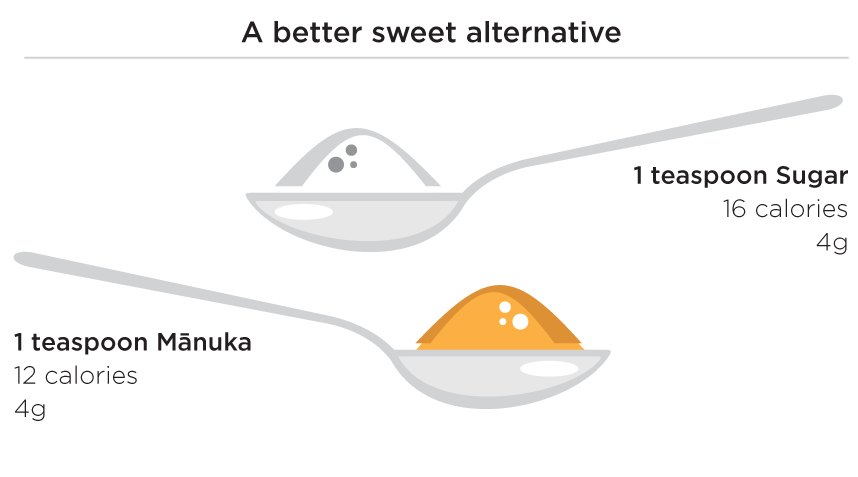Manuka Honey
YOUR GUIDE TO UNDERSTANDING MANUKA HONEY
Manuka honey benefits are by far the biggest reason people consume Manuka honey.
Manuka honey is distinct in taste, colour, and viscosity, and the purest New Zealand Manuka honey contains uniquely high levels of the anti-bacterial compound Methylglyoxal. It is the high levels of Methylglyoxal that makes Manuka honey suitable for advanced wound care dressings, skin treatments, premium cosmetics and makes it a genuine superfood.
The PURITI team would also like everyone to know that genuine New Zealand Manuka is far more than just the content of Methylglyoxal.
GENUINE MANUKA HONEY
Genuine Manuka honey is a product of the wonderful resourceful bee. Beekeeping is a highly specialised skill. To make the honey the bees collect nectar from the Manuka Bush. The word Manuka is from the Maori language. It is the Maori name given to this indigenous native bush of New Zealand, otherwise known as Leptospermum scoparium.
Manuka has a long and strong association with indigenous Maori traditional natural medicine. The Manuka leaves, bark, oil and ash have all been used for various ailments. It is little wonder that the initial growth and demand for Manuka honey originated in Asian countries where alternative, traditional and natural remedies are held in such high esteem.
Most Manuka trees grow in remote areas and genuine wilderness. New Zealand is one of the cleanest natural environments in the world. New Zealand has some of the most spectacular and diverse landscapes on the planet. Agricultural products and natural products from New Zealand are highly regarded, sought-after and accepted for their renowned quality and purity.
Genuine Manuka honey is exceptionally rare and unique to New Zealand. To ensure the purest product, it must be harvested, extracted, tested, certified and packed in New Zealand.
Manuka Honey Certifications
PURITI is the only brand to have both UMF and MGO certifications clearly shown on all labelling and packaging.
UMF and MGO ratings are both used to indicate the potency and strength of Manuka honey. UMF is an industry standard - more established and widely used and it stands for ‘Unique Manuka Factor.’
UMF and MGO measure and define the strength/potency of Manuka differently, however, there is a relationship and direct correlation between the level of Methylglyoxal and the Non-Peroxide Activity (as measured by the UMF).
Table of UMF and MGO comparison:

| UMF RATING | MGO* |
|---|---|
| UMF 5+ | 83 |
| UMF 10+ | 263 |
| UMF 12+ | 354 |
| UMF 15+ | 514 |
| UMF 18+ | 692 |
| UMF 20+ | 829 |
* MGO is measured as methylglyoxal mg/kg (ppm)
PURITI products are all produced to a higher MGO level than required to pass the UMF grading levels.
Compare to PURITI’s even higher standards chartManuka Health Benefits
Unlike refined, processed sugar and other sweet alternatives (i.e. Stevia), Manuka honey is far more than empty calories. It is more than a taste; Manuka honey is a complex superfood that contains an abundance of nutritional and well-being benefits and has around four times the mineral content of other honey.
| Minerals found in Manuka honey | Vitamins found in Manuka honey |
|---|---|
| Calcium | B6 |
| Copper | Thiamine |
| Iron | Niacin |
| Magnesium | Riboflavin |
| Manganese | Pantothenic acid |
| Phosphorous | Amino acids |
| Potassium | |
| Sodium | |
| Zinc |

- Manuka honey is a sweeter, more nutritional and lower calorie alternative to sugar with a more balanced energy release
- Fast release Glucose for energy recovery
This natural sweetener is rich in phenolic acids and flavonoids, which make it a powerful source of natural antioxidants.
Know Your Real Manuka Honey
Telltale signs to look out for when purchasing Manuka honey in New Zealand and overseas.
All PURITI jars are clear so you know exactly what you are buying, and you can easily see for yourself the superior attributes of PURITI Manuka honey which is in stark contrast to many other Manuka honey brands in the marketplace that use non-transparent and dark containers thereby being impossible to check on the following:
| High-Quality Manuka vs Low-Quality Manuka |
|---|
| Colour |
| Light amber/brown | Pale |
| Medium amber/brown | Dark brown |
| Streaky |
| Taste |
| Medium sweetness | Herbal nodes |
| Slightly bitter aftertaste | Overly sweet |
| Nutty nodes | Sharp bitterness |
| Aroma |
| Slightly nutty | Distinct fruit smell |
| Damp earthy | Distinct floral smell |
| Herbal aromatic |
| Texture |
| Gel like consistency | Very runny |
| Viscous | Overly firm |
PURITI honey is produced to a standard that raises the bar on purity and quality. We do not share common ground with any other Manuka honey brands. We define higher standards and everything we do is underpinned by honesty, integrity and transparency.
FREQUENTLY ASKED QUESTIONS ABOUT MANUKA HONEY
Monofloral honey produced from the nectar of New Zealand's native Manuka tree. It is often purchased as an alternative to natural remedy or traditional medicine.
Manuka honey has proven antiviral, anti-inflammatory and antioxidant benefits when used or applied topically to the skin. In fact, it has a long anecdotal history of medicinal use and has traditionally been used for wound healing, soothing sore throats, preventing tooth decay, joint pain, improving digestive issues and more.
Firstly, it is completely unique to New Zealand and made by bees that pollinate the Manuka bush and collect the nectar. There is a unique symbiotic relationship between the honey bee and the Manuka bush. It is one of the most unique highly regarded and most sought-after forms of honey in the world. It is also believed by many to help heal and improve health, vitality and well-being in many ways.
When feeling cold or flu symptoms, many people choose to take one teaspoon of Manuka honey 3-4 times a day. Unique properties (anti-inflammatory, antibacterial, and antiviral) have been identified and found in genuine Manuka products, soothing sore throats and giving relief to other symptoms.
Honey has a very long life and doesn't really ‘expire’ anytime soon. Stored properly and at room temperature, honey can last for several years. Products that are sometimes mixed with honeys are more likely to go bad sooner, but PURITI is produced to higher purity and superior standards.
It does tend to be more expensive than other kinds of honey due to its unique nutritional properties and rarity. The testing process is far more stringent to ensure the authenticity, purity and the quality of the product. If your purchasing decision is based on the price you probably won’t be buying PURITI. Unfortunately making the best is not usually conducive to making the cheapest. Price goes with the territory and you get what you pay for. PURITI’s high-quality Manuka Honey’s price directly reflects the high quality of the product.
Unique Manuka Factor
UMF is a registered quality mark identifying Manuka honey that has the special natural property found only in some strains. The UMF grading system appraises the natural markers found in Manuka honey and assures purity and quality. UMF is one of a number of different grading systems adopted throughout the world. It is highly regarded and one of the most recognisable and well-known measures.
MGO stands for the natural chemical methylglyoxal, sometimes referred to as MG. Methylglyoxal is the naturally occurring compound found and identified in genuine New Zealand Manuka honey.
An extensive industry consultation was performed prior to the end of 2017 and the Ministry for Primary Industries (MPI) made its decision on the scientific definition of Manuka honey. It states that four chemical markers from nectar and one DNA marker from Manuka pollen must be at a certain level to meet overseas export requirements. Rules were to apply from February 5th, 2018. PURITI decided to voluntarily apply these standards to their products sold in New Zealand as well. Please click here for PDF infographic download
PURITI also decided to raise the bar over and above the MPI Manuka Honey Science Definition. The pass mark for all 4 chemical markers is set considerably higher for all PURITI products.
A few ways to eat it:
1. Take one to two teaspoons daily for good natural health maintenance.
2. Use as a uniquely tasting sweetener for your tea with fewer calories.
3. Use as a natural sweetener and energy source for smoothies.
4. Combine with citrus and vinegar as a salad dressing.
5. Combine with soy sauce, garlic and ginger for a great stir-fry sauce.
6. Mix into warm milk before bedtime to aid a restful sleep.
7. Mix into warm water with lemon and ginger as a daily tonic.
8. Take as a natural energy source to support exercise and daily workload.
A few other common uses:
1. Aid natural wound healing - apply to burns, ulcers and non-healing wounds.
2. Promote oral health - inhibiting the growth of harmful bacteria and helps treat gingivitis and tooth decay.
3. Skincare. Use as a natural skin moisturizer, toner and facial mask - used to treat acne, dry skin, etc.
4. Organ health - The honey’s potent antibacterial effects may help with gut health and digestion.
...Much much more can be found in the Medical Scientific Studies section
INTERNATIONAL AND NZ MANUKA HONEY MEDICAL SCIENTIFIC STUDIES
Manuka has been the subject of numerous scientific studies at the University of Waikato in New Zealand, Cardiff in the UK and many other centres of study around the world. It is still being studied by scientists in New Zealand and around the world on an ongoing and continuous basis. Many in the medical and scientific community believe that we have only scratched the surface of Manuka’s use and capability. The processes involved are long and complex. Many within the scientific community believe that major advances in our understanding of Manuka will be achieved over the next decade.
Here are a few references (links) to some of the scientific studies that have been done to date.
- The effect of Manuka honey on enterobacteria
- Antioxidant Activity of Phenolic Components of Manuka honey
- Manuka honey as an antiviral agent against respiratory syncytial virus
- The antibacterial activity of Manuka honey: 1. The nature of the antibacterial activity
- The antibacterial activity of Manuka honey: 2. Variation in the potency of the antibacterial activity
- Re-introducing Manuka honey in the management of wounds and ulcers - theory and practice
- The controlled in vitro susceptibility of gastrointestinal pathogens to the antibacterial effect of Manuka honey
- The use of Manuka honey in healing a recalcitrant wound following surgical treatment of hidradenitis suppurativa
- Using Manuka honey in wound care
- Clinical usage of Manuka honey as a wound dressing: An update
- The role of Manuka honey in the management of wounds
- Using Manuka honey to heal diabetic foot ulcers
- The evidence supporting the use of Manuka honey as a wound dressing
- Why Manuka honey is effective as a medicine. 1. Its use in modern medicine
- Why Manuka honey is effective as a medicine. 2. The scientific explanation of its effects
For more information on scientific research being done in New Zealand, go to the Waikato University Research Commons and do a search for Manuka Honey.
